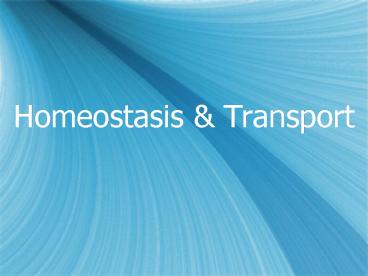Homeostasis - PowerPoint PPT Presentation
1 / 45
Title:
Homeostasis
Description:
Cells maintain homeostasis by controlling and regulating what ... Contractile Vacuoles. Contractile Vacuole: an organelle in microorganisms that excretes water ... – PowerPoint PPT presentation
Number of Views:79
Avg rating:3.0/5.0
Title: Homeostasis
1
Homeostasis Transport
2
Section 1 Diffusion Osmosis
3
Homeostasis
- Homeostasis the biological balance between a
cell or an organism and its environment - Cells maintain homeostasis by controlling and
regulating what gets into and out of the cell.
4
Diffusion
- Diffusion the process by which molecules move
from an area of greater concentration to an area
of lower concentration
5
Diffusion
6
BrownianMotion
- Brownian Motion molecules are in a constant
state of random motion
7
BrownianMotion
8
Concentration Gradient
- Concentration Gradient the difference in
concentration of a substance across a space
9
Dynamic Equilibrium
- Dynamic Equilibrium a state that exists when the
concentration of a substance is the same
throughout a space
10
Dynamic Equilibrium
11
Review of Cell Membrane Structure
12
Diffusion Across Membranes
- Not all molecules can diffuse through all
membranes. - The ability of a molecule to pass through a
membrane depends on the size and type of molecule
and the molecular structure of the membrane.
Small nonpolar molecules can diffuse through the
cell membrane
13
Osmosis
- Osmosis the diffusion of water molecules through
a selectively permeable membrane from an area of
high water concentration to an area of lower
water concentration
14
Osmosis
15
Three Types of Solutions
90 H2O 10 solute
85 H2O 15 solute
95 H2O 5 solute
90 H2O 10 solute
90 H2O 10 solute
90 H2O 10 solute
Hypotonic
Hypertonic
Isotonic (no net movement of water)
16
Three Types of Solutions
Plant Cells
17
Three Types of Solutions
Animal Cells
18
Three Types of Solutions
Cytolysis
Plasmolysis
19
Three Types of Solutions
20
Contractile Vacuoles
- Contractile Vacuole an organelle in
microorganisms that excretes water - collect excess water ? contract ? squeeze out
water
21
Study the diagram below. It represents a
container that is divided by a semipermeable
membrane. A different solution in its initial
state is shown on each side of the membrane.
1. Describe which molecule(s) will move through
the membrane and which molecule(s) will
not. 2. Describe the relative rates at which the
molecule(s) will move across the
membrane. 3. Describe in which direction the
molecule(s) will move. 4. Describe how long the
molecule(s) will continue to move.
22
Section 2 Other Kinds of Transport
23
Review of Cell Membrane Structure
24
Review of Cell Membrane Structure
25
Passive Transport
- Passive Transport the movement of any substance
across a cell membrane without the use of cell
energy - Diffusion
- Osmosis
- Facilitated Diffusion
- Gated Channel
26
Facilitated Diffusion
- Facilitated Diffusion a process in which
substances move down their concentration gradient
across the cell membrane with the assistance of
carrier proteins - Examples glucose, fructose, ions
27
FacilitatedDiffusion
28
Facilitated Diffusion
29
(No Transcript)
30
Gated Channel
- Gated Channel a protein-lined gated passage
making cell membranes permeable to certain large
molecules as needed - Example neuromuscular function
31
Gated Channel
32
Active Transport
- Active Transport the movement of any substance
across a cell membrane with the use of energy
from ATP - Sodium-Potassium Pump
- Endocytosis
- Exocytosis
33
Sodium-Potassium Pump
- Sodium-Potassium Pump an active transport
mechanism that moves ions in order to achieve
polarization
34
(No Transcript)
35
(No Transcript)
36
Proton Pump
- Proton Pump an active transport mechanism that
consumes ATP (energy) to force Hydrogen ions
against the concentration gradient
37
Proton Pump
38
Proton Pump
39
Endocytosis
- Endocytosis the process by which a cell engulfs
and surrounds large substances
40
Endocytosis
41
Exocytosis
- Exocytosis the process by which wastes are
packaged in vesicles and leave the cell
42
Exocytosis
43
Passive vs.ActiveTransport
44
Passive vs. Active Transport
45
(No Transcript)































